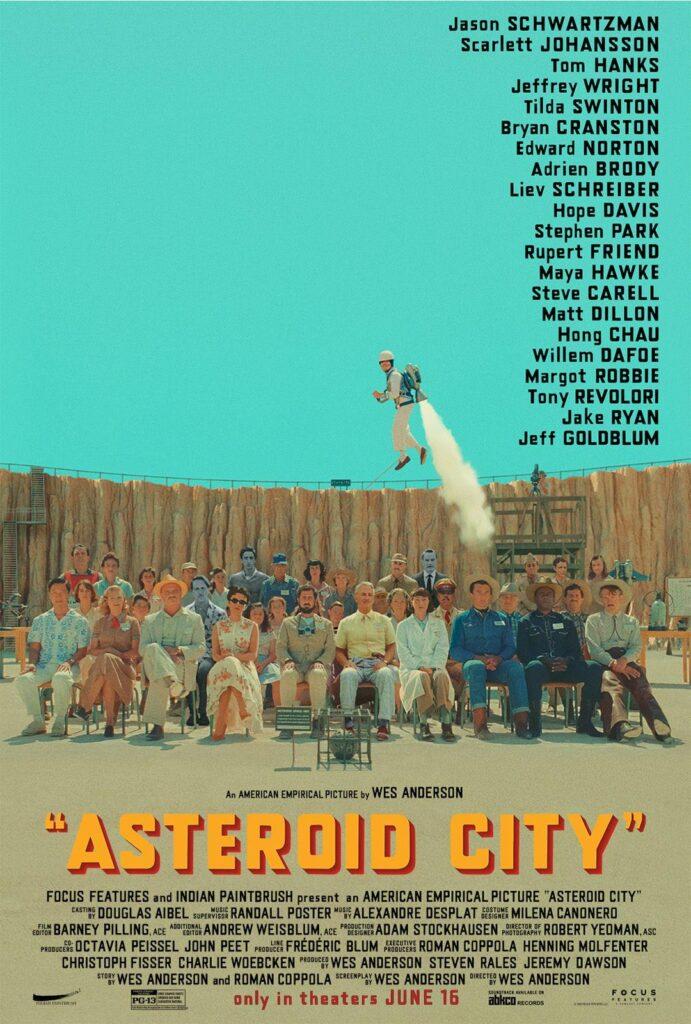Asteroid City: a fictional American desert town, circa 1955. Junior Stargazers and Space Cadets from across the country assemble for the annual Asteroid Day celebration—but the scholarly competition is spectacularly upended by world-changing events. Equal parts comedy, drama, and romance (with a touch of science-fiction). Directed by Wes Anderson and features an all-star cast including Jason Schwartzman, Scarlett Johansson, and Tom Hanks. If postmodernism is about having a skeptical approach to the text, then Asteroid City (2023) is perhaps the most postmodern of contemporary tales. American director Wes Anderson’s latest film conveys this and more.
The most important element is the screenplay. It allows Wes to be as meticulous as he needs to be while leveraging (dipping into) the Postmodern—this film is self-referential, and self-conscious and constantly breaks down the 4th wall just to highlight its awareness that it is indeed fiction. It is a screenplay about an unfinished play that takes place on a movie set that is being televised live from a theater in New York. And it has a narrator that constantly reminds you of that.

The story is fragmented and non-linear, and as soon as you start to fall into a standard narrative structure, you are jarred back out of it: You Can’t Wake Up if you Don’t Fall Asleep (you must reject the narrative before you can embrace it). It’s like Nabokov’s Pale Fire, which he takes from Timon of Athens, “The moon’s an arrant thief, And her pale fire she snatches from the sun.”
Intertextual, it takes (steals) from lit, art, philosophy, and pop culture to create its reality…the unfinished overpass is the symbol.
Wes Anderson’s films exhibit several characteristics associated with postmodern literature and film, although they are primarily cinematic works rather than literature per se. Nevertheless, Anderson’s distinctive style and narrative techniques align with many aspects of postmodernism:
Anderson’s films are renowned for their meticulously crafted visual aesthetic, characterized by symmetrical compositions, vibrant color palettes, and carefully designed sets. This attention to detail often creates a sense of artificiality and self-awareness, reminiscent of the self-consciousness found in postmodern literature.
Anderson’s films feature eccentric and idiosyncratic characters whose identities are often fragmented or in flux. These characters struggle with issues of belonging, identity, and alienation, reflecting the postmodern preoccupation with the instability of selfhood.
Anderson frequently employs non-linear storytelling techniques and fragmented narrative structures in his films. He often juxtaposes multiple storylines and employs unconventional narrative devices such as voiceover narration and flashback sequences, echoing the fragmented and non-linear narratives found in postmodern literature.
Anderson’s films are rich in intertextual references to literature, art, cinema, and popular culture. He pays homage to various cultural artifacts and artistic movements, blurring the boundaries between high and low culture and inviting viewers to engage in a game of cultural recognition, a characteristic of postmodern literature.
Anderson’s films often employ irony and parody to comment on social norms, cultural conventions, and cinematic tropes. His use of deadpan humor and exaggerated situations creates a sense of irony and detachment, which are key features of postmodern literature and film.
Many of Anderson’s films explore themes such as alienation, nostalgia, and the search for meaning in a chaotic world, which are central concerns of postmodern literature and film.
While Anderson’s films may not adhere strictly to the conventions of postmodern literature, they share many thematic and stylistic elements with the movement. His unique blend of visual style, narrative techniques, and thematic concerns has earned him a place within the broader tradition of postmodern art and culture.
Discover more from CAPE CHARLES MIRROR
Subscribe to get the latest posts sent to your email.
Leave a Reply